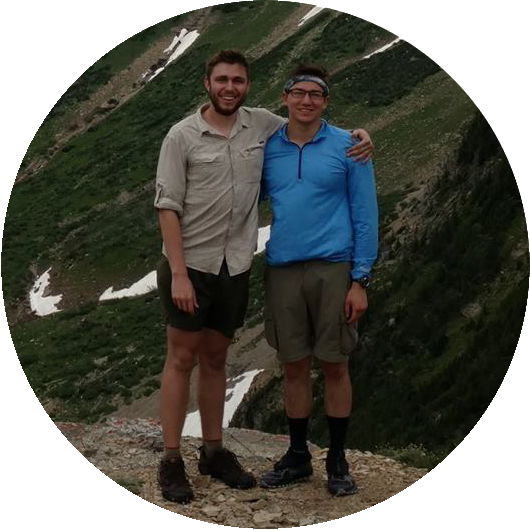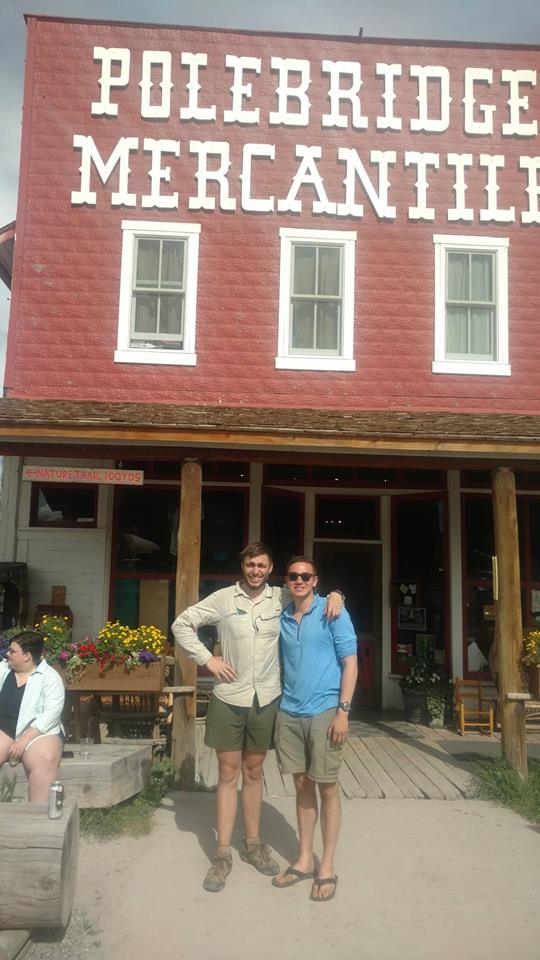
Alumni Perspective by
Doug O’Laughlin BS’16 and Charlie Hannigan BS’16
Editors’ Note: This feature appears as it was published in the fall 2017 edition of UT Dallas Magazine. Titles or faculty members listed may have changed since that time.
The Pacific Northwest Trail (PNT) stretches from Montana to the Pacific Ocean and encompasses some of the most difficult hiking terrain in the United States. Unkempt trails, Rocky Mountain peaks and an unforgiving route confront every hiker who embarks on it. Two newly minted UTD graduates began their post-collegiate lives with the same mission — to test themselves with a trek into the wilderness. What they didn’t expect and didn’t know they wanted were challenges too big to handle alone. Luckily, on the first day of a 140-mile trip through part of the PNT, they met each other.
Doug O’Laughlin BS’16 and Charlie Hannigan BS’16, whose nine-day trek transformed them from strangers to lifelong friends, recall their adventures on the trail.

Charlie
I spent my last few days in civilization with Mike Coleman (Dr. J. Michael Coleman), the former dean of undergraduate education at UT Dallas. Being the gracious host, he picked me up from the Kalispell City Airport, helped me get the last few items for my hike and took me to the trailhead. After we said our goodbyes, I was alone in the forest with some of the most beautiful sights I had ever seen. Thirteen miles, a waterfall and plenty of sweat later, I set down at my first campsite of the trip, one with a beautiful mountain view and a great place to eat. I heard someone approaching, whistling down the trail. We greeted each other as he neared the campsite, and I invited him to grab some food. I had no idea I was about to meet a best friend.
Doug
My first thoughts on the Pacific Northwest Trail started as “Wow, I’m really here” and quickly shifted to “Oh crap, I’m really here, and I don’t know what the hell I’m doing.” My careful planning — from overnight trips to a meticulous food plan to packing my backpack over and over again — did not in any way prepare me for the majesty and stark fear of taking my first steps alone into Glacier National Park. I started late in the day and was anxious to make camp. The first day had been long, lonely and a little unsettling. As I walked into the campsite, I spotted a friendly looking guy in an orange jacket. I casually asked him, “Hey, what brings you here?” It was then, around a campfire and nursing our sore feet, that we discovered we shared an orange-and-green history.

Charlie Hannigan BS’16 (left) and Doug O’Laughlin BS’16
Our New Trip, Together
Our stories began separately, but before the first day of hiking together was over, we had become a team.
We soon found that we shared the same favorite book and the same favorite shows, games and hobbies. Most remarkably, we were in the same graduating class — yet had never met. But in the backcountry, hundreds of miles away from Texas, two strangers were becoming the best of friends.
Long-distance hiking has its own lingo, with terms such as “trail magic” — unexpected acts of kindness or experiences that lift a hiker’s morale. For us, it was real. Our meeting could only be described as trail magic — two Comets out in the woods on the same day, in the same campsite, going the same direction.
A Day Full of Challenges
 We faced our first challenge as a team the very next day. We were climbing toward Stoney Indian Pass. Advisories and online postings warned that the pass was snowed in and too dangerous to cross. The all-knowing park rangers had marked our itineraries as “not advised.” It may seem that we were disregarding these warnings, but other hikers — with seemingly more current information — had told us the trail was fine. We decided to give it a go.
We faced our first challenge as a team the very next day. We were climbing toward Stoney Indian Pass. Advisories and online postings warned that the pass was snowed in and too dangerous to cross. The all-knowing park rangers had marked our itineraries as “not advised.” It may seem that we were disregarding these warnings, but other hikers — with seemingly more current information — had told us the trail was fine. We decided to give it a go.
As expected, the pass was covered in snow. But we leaned in — if we were going to do this, we were going to do it together. After a nerve-wracking hour of sliding and questioning the presence of snow in July, we made it to Stoney Indian Lake.
Facing our fears together changed something. We were hiking the PNT as a team.
Toward the end of that day, we came upon our second big challenge, and one of the biggest scares either of us had ever faced — a grizzly bear just 30 feet from us.
 Glacier National Park, where we were hiking, has a very high concentration of grizzlies. We had been on high alert, especially since a grizzly killed someone in the park the day before we began our hike. We were always on the lookout for bear tracks. If they looked fresh — and boy, did they — we knew to be extra vigilant.
Glacier National Park, where we were hiking, has a very high concentration of grizzlies. We had been on high alert, especially since a grizzly killed someone in the park the day before we began our hike. We were always on the lookout for bear tracks. If they looked fresh — and boy, did they — we knew to be extra vigilant.
As we got farther down the west side of the Rockies, we were seeing bear tracks and scat more frequently. Our solution: constantly singing and shouting to make our presence known. Coming down into a ravine, Charlie remarked, “Hey, look at that little meadow. That would be perfect for a grizzly. Let’s call that a little bear meadow.”
Probably 30 seconds later, Doug gasped, “Bear!” and as we looked into that meadow, we saw a young grizzly about 30 feet away. We had been told a lot about bear safety before entering the park, but most of that information went out the window when we saw one. Frozen in place, we were barely able to pull out the pepper spray. Even though we weren’t supposed to, we locked eyes with the bear. Doug had the presence of mind to begin calmly talking to it. Luckily, just a few tight breaths later, the bear galloped away — 300 pounds of power running faster than we could ever hope to run, and thankfully in the opposite direction.
In the moment, we were silent. We hiked — ran — the last 2 miles to our campsite. Looking death in the face brought all barriers down. We were too scared to be polite or hide our tears. In a single day, we grew closer than we had ever thought possible.
Long-distance hiking has its own lingo, with terms such as “trail magic” — unexpected acts of kindness or experiences that lift a hiker’s morale. For us, it was real. Our meeting could only be described as trail magic — two Comets out in the woods on the same day, in the same campsite, going the same direction.
Chilled to the Bone
After a few days in Polebridge, Montana, where we enjoyed relative comfort and relaxation, we resumed the hike. At this point, we were encountering rain or mist, day in and day out. One day of rain is annoying, but multiple days of 40-degree driving rain turns scary. Our gear had wet out, our muscles were cramping, and we faced our next challenge — a close call with hypothermia.
 On this particular day, after hiking 21 miles and going 6,000 feet up and down, we decided to stop and make camp. It had been a long day of relentless rain, constant fear of bears and just generally dashed spirits. (Coming off a lazy stay in Polebridge, it was like, “Why did we leave?!”) Temperatures started to drop, and we fumbled through our nighttime routine. It went slowly. Our lips were turning blue. Hopping into our tents, we got dry and started to warm up. It took an hour to stop shaking.
On this particular day, after hiking 21 miles and going 6,000 feet up and down, we decided to stop and make camp. It had been a long day of relentless rain, constant fear of bears and just generally dashed spirits. (Coming off a lazy stay in Polebridge, it was like, “Why did we leave?!”) Temperatures started to drop, and we fumbled through our nighttime routine. It went slowly. Our lips were turning blue. Hopping into our tents, we got dry and started to warm up. It took an hour to stop shaking.
Corny takeaway time: This is also where it was great. While we were each shivering on that exposed mountain with what seemed to be hypothermia, we also realized that this would have been an impossible trip alone.
We have a highlight reel of the little moments that made this challenging trip so much tougher. Our lows of taped toes, crying, being lost and wanting water were only bearable together. That hour we talked, reassuring each other before we could finally feel our feet, was one of the longest but most important talks we ever had.
A Dark and Stormy Last Day
But with every challenge and every night come a new day. We would wake up, change into wet clothes, pick up our packs and continue onward. Onward and onward. Sometimes, it felt like it would never end.
But it did — we reached our final day together. It started out with us in our highest spirits yet. Beautiful views and the dead-set certainty of seeing Polebridge that night solidified our determination to beat the storm gathering at our back.
 Things quickly went bad. Occasional bursts of lightning became strings of lightning. When the rain started to go sideways, we took stock of our situation. While not quite exposed, we were high up, and each bolt struck closer and closer. We made a series of mistakes, beginning when we bailed off the trail into the trees and huddled in modified fetal positions with our heels off the ground for about 30 minutes. Thunder strummed, shaking us, and lightning left afterimages even through closed eyes.
Things quickly went bad. Occasional bursts of lightning became strings of lightning. When the rain started to go sideways, we took stock of our situation. While not quite exposed, we were high up, and each bolt struck closer and closer. We made a series of mistakes, beginning when we bailed off the trail into the trees and huddled in modified fetal positions with our heels off the ground for about 30 minutes. Thunder strummed, shaking us, and lightning left afterimages even through closed eyes.
The storm’s ferocity brought our spirits to their lowest yet.
There were tears and reassurances like “I love you, man; we got this.” We decided to push the button on our satellite beacon to signal Charlie’s family that things were not OK and we needed to be bailed out, ASAP.
That huddle seemed to last a lifetime. One of us finally peeked out from underneath a makeshift tarp, only to find that the storm was over. The trail had flooded, a tree 100 yards from us had been downed, but we were all right. The world had seemed to be coming down over our heads. Yet when it was all done, the storm cleared up for some beautiful views of the plain below the switchback.
We agreed that neither of us had ever been more scared of something or more grateful for something to be over.

Our last lesson on the last day of our trek was, unsurprisingly, that this, too, shall pass. The worst thing that happened to us on the trail did eventually pass. Our final takeaway from that lesson: Through each other’s strength, we can make it and always will. Always. And it will be beautiful and meaningful and awesome on the other side.
Both of us label that moment of huddled fear as the most memorable and defining — not the “wahoo” moments at the top of a pass or a beautiful vista, but making it through a storm together. That really was the climax of our trip.
We may have walked off the trail, but in some ways, we have never really parted. We are meaningful, lifelong friends now, in a way that can only be forged through truly testing times. We still talk daily, and despite all the storms — both internal and external — that we weathered, we continue to plan hikes together.




